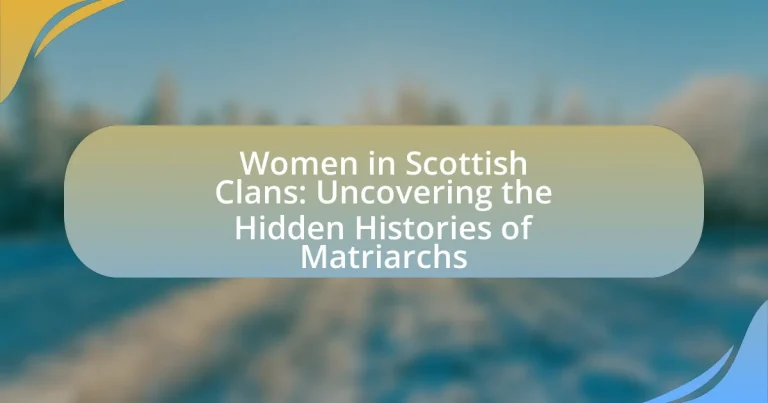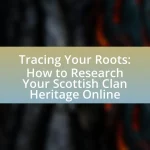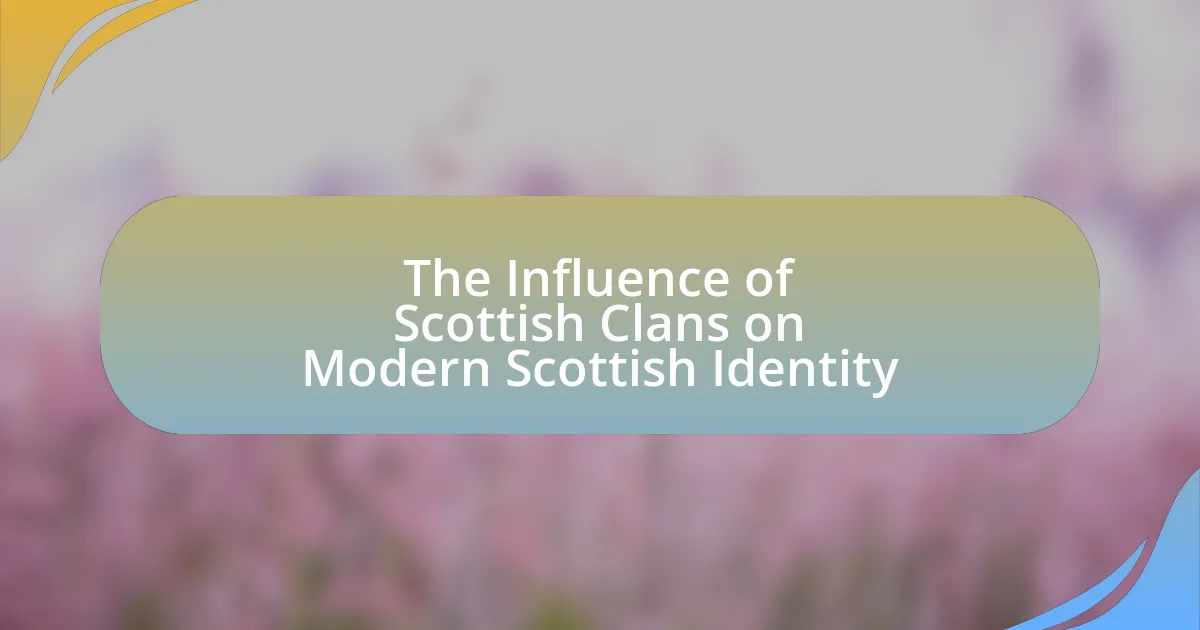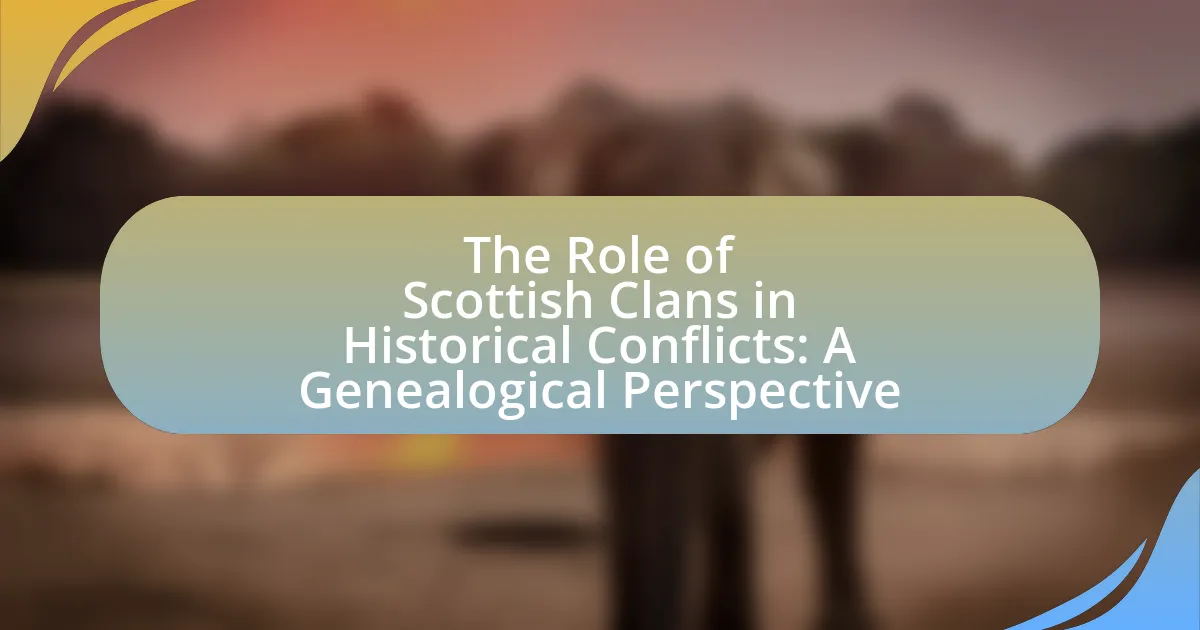The article “Women in Scottish Clans: Uncovering the Hidden Histories of Matriarchs” examines the significant roles women played within Scottish clans, highlighting their contributions as matriarchs, caretakers, and negotiators. It discusses the evolution of women’s status from traditional domestic roles to influential positions in clan leadership and decision-making, particularly during historical events such as the Jacobite risings. The article also explores the economic roles of women, their impact on clan politics, and the legacies left by notable matriarchs, while addressing the societal norms that have historically marginalized their stories. Additionally, it emphasizes the modern implications of these histories for gender equality and cultural identity in Scotland.
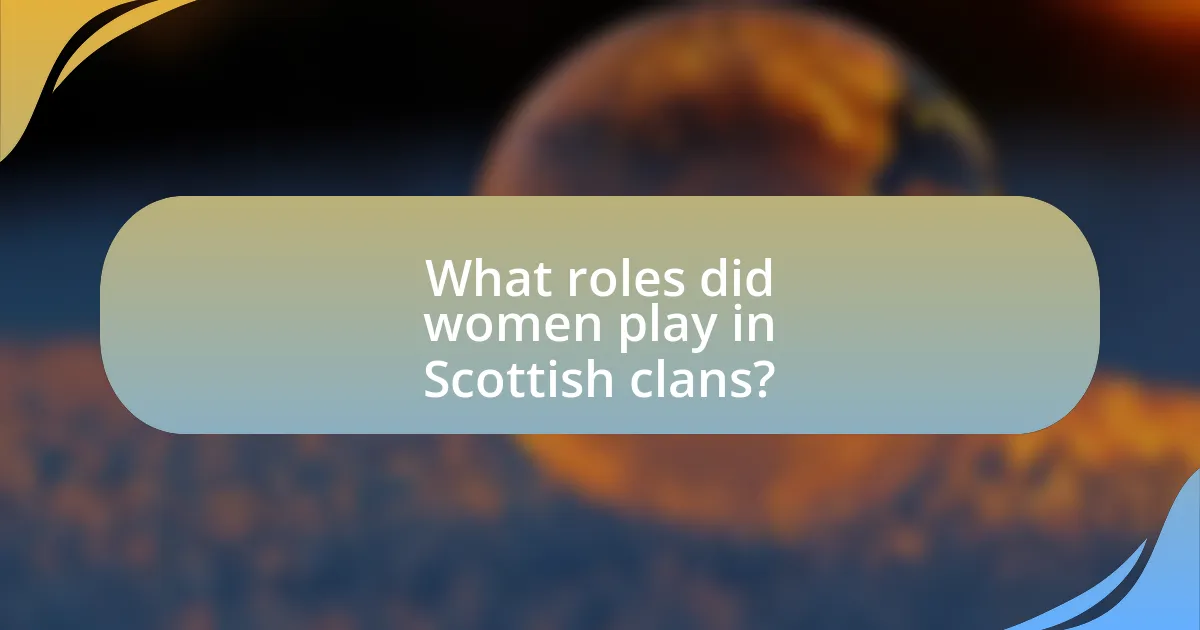
What roles did women play in Scottish clans?
Women in Scottish clans played crucial roles as matriarchs, caretakers, and negotiators. They were responsible for managing household affairs, raising children, and preserving clan traditions. Additionally, women often acted as mediators in disputes and were involved in the economic activities of the clan, such as agriculture and textile production. Historical records indicate that women could inherit land and titles, particularly in cases where there were no male heirs, which underscores their significant influence within clan structures.
How did the status of women in clans evolve over time?
The status of women in Scottish clans evolved from being primarily domestic figures to gaining significant roles in clan leadership and decision-making. Initially, women were largely confined to traditional roles, managing households and raising children, with limited influence in clan affairs. However, over time, particularly during the late medieval period, women began to inherit titles and land, especially in the absence of male heirs, which allowed them to wield power and influence within their clans. Historical records indicate that women like Isabella MacDonald and Margaret Stewart played crucial roles in clan politics and alliances, demonstrating their increasing importance in clan dynamics. This shift reflects broader societal changes that recognized women’s contributions beyond domestic spheres, leading to a more nuanced understanding of their roles in Scottish history.
What historical events influenced women’s roles in Scottish clans?
Historical events such as the Jacobite risings and the clan system’s evolution significantly influenced women’s roles in Scottish clans. During the Jacobite risings in the 18th century, women often took on leadership roles, managing estates and supporting military efforts while men were away. The clan system, which emphasized kinship and loyalty, allowed women to inherit property and wield influence, particularly in the absence of male heirs. Additionally, the legal changes brought about by the Marriage and Divorce Act of 1857 further altered women’s status, granting them more rights within the clan structure. These events collectively shaped the social and political landscape, enhancing women’s roles in Scottish clans.
How did clan structure impact women’s positions within the family?
Clan structure significantly influenced women’s positions within the family by often relegating them to subordinate roles, while simultaneously granting them certain responsibilities and privileges. In many Scottish clans, lineage and inheritance were patrilineal, meaning property and titles passed through male members, which limited women’s economic power and decision-making authority. However, women could hold vital roles as matriarchs, managing household affairs and maintaining clan traditions, which provided them with a degree of influence within the family unit. Historical records indicate that women in clans sometimes acted as key negotiators in alliances and marriages, showcasing their importance despite the overarching patriarchal framework.
What contributions did women make to clan life?
Women made significant contributions to clan life by serving as key figures in social, economic, and cultural spheres. They were responsible for managing household affairs, which included food production, textile creation, and child-rearing, thereby ensuring the clan’s sustainability. Additionally, women often played vital roles in maintaining clan traditions and oral histories, passing down knowledge and cultural practices through generations. Historical records indicate that women could also hold property rights and influence clan decisions, particularly in matrilineal societies, where lineage and inheritance were traced through the female line. This involvement not only reinforced clan unity but also empowered women within their communities, highlighting their essential role in the fabric of clan life.
How did women influence clan politics and decision-making?
Women influenced clan politics and decision-making by serving as key negotiators, advisors, and custodians of clan heritage. Their roles often included mediating disputes, arranging marriages to strengthen alliances, and managing clan resources, which directly impacted political dynamics. Historical records indicate that women like the Countess of Buchan played significant roles in clan leadership and decision-making processes, demonstrating their influence in shaping clan strategies and alliances. Additionally, women’s involvement in the transmission of oral histories and cultural practices reinforced their authority and importance within clan structures, further solidifying their impact on political decisions.
What were the economic roles of women in Scottish clans?
Women in Scottish clans played crucial economic roles, primarily in agriculture, textile production, and managing household resources. They were responsible for cultivating crops, tending livestock, and producing essential goods such as wool and linen, which were vital for both domestic use and trade. Historical records indicate that women often managed the clan’s finances, overseeing the distribution of resources and ensuring the economic stability of their households. Additionally, women participated in local markets, selling surplus produce and handmade items, thereby contributing to the clan’s overall wealth and sustainability.
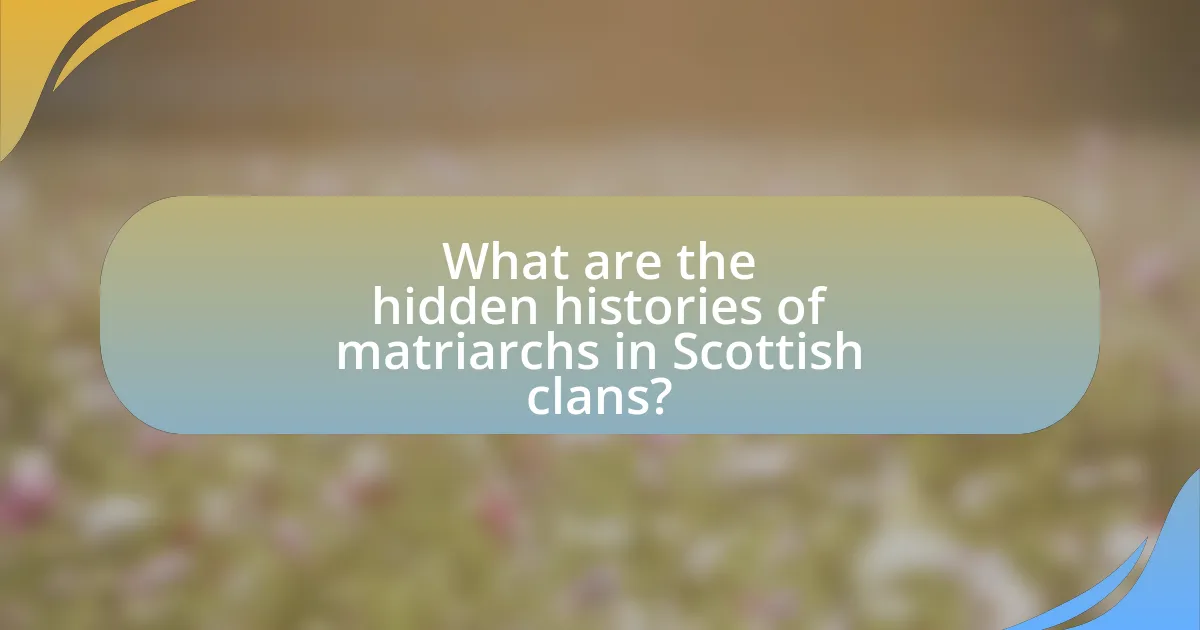
What are the hidden histories of matriarchs in Scottish clans?
The hidden histories of matriarchs in Scottish clans reveal their significant roles in lineage, governance, and cultural preservation. Matriarchs often held power through inheritance, influencing clan decisions and maintaining family legacies, as evidenced by figures like Margaret Stewart, who wielded authority in the 15th century. Additionally, women such as Lady Anne Gordon played crucial roles in clan alliances and land management, demonstrating their impact on socio-political dynamics. Historical records, including clan charters and oral traditions, highlight these women’s contributions, which have often been overlooked in mainstream narratives.
Who are some notable matriarchs in Scottish clan history?
Notable matriarchs in Scottish clan history include Margaret Stewart, who was instrumental in the governance of the Clan Stewart during the 15th century, and Isabella MacDonald, known for her role in the Clan MacDonald and her influence in the clan’s alliances. Additionally, Lady Agnes Campbell, a prominent figure in the Clan Campbell, played a significant role in clan politics and land management in the 16th century. These women exemplified leadership and influence within their clans, shaping their legacies and the broader Scottish history.
What legacies did these matriarchs leave behind?
The matriarchs of Scottish clans left behind legacies of leadership, cultural preservation, and social influence. These women often played crucial roles in clan governance, managing resources, and maintaining traditions, which helped to sustain clan identity over generations. For instance, figures like Margaret Stewart, who was instrumental in clan alliances, exemplify how matriarchs shaped political landscapes. Additionally, their contributions to oral history and storytelling ensured the transmission of cultural values and clan histories, reinforcing community bonds. Their legacies are evident in the continued reverence for clan traditions and the recognition of women’s roles in Scottish heritage.
How did their actions shape the future of their clans?
The actions of women in Scottish clans significantly shaped the future of their clans by influencing leadership roles and preserving cultural traditions. For instance, women often acted as key decision-makers during times of conflict, ensuring the survival and continuity of their clans. Historical records indicate that women like Isabella MacDonald and Margaret Stewart wielded considerable power, managing estates and negotiating alliances, which directly impacted clan stability and prosperity. Their involvement in clan governance and social structures laid the groundwork for future generations, fostering a legacy of female leadership that would influence clan dynamics for years to come.
Why are the stories of women in clans often overlooked?
The stories of women in clans are often overlooked due to historical patriarchal structures that prioritized male narratives and leadership roles. This systemic bias has led to a lack of documentation and recognition of women’s contributions within clan histories. For instance, many historical records focus on male lineage and achievements, while women’s roles, such as caretakers, negotiators, and cultural transmitters, remain underrepresented. Additionally, cultural norms have traditionally marginalized women’s voices, further contributing to their stories being neglected in clan histories.
What societal norms contributed to the marginalization of women’s histories?
Societal norms that contributed to the marginalization of women’s histories include patriarchal structures that prioritized male narratives and roles over female contributions. Historically, these norms dictated that women’s primary responsibilities were domestic, leading to their exclusion from formal historical records and decision-making processes. For instance, in many Scottish clans, lineage and inheritance were traced through male heirs, which diminished the visibility of women’s roles in leadership and governance. Additionally, cultural perceptions that deemed women’s experiences as less significant reinforced the idea that their stories were not worthy of documentation, further obscuring their contributions to clan histories.
How can we uncover and preserve these hidden histories?
To uncover and preserve hidden histories of women in Scottish clans, researchers can utilize archival research, oral histories, and community engagement. Archival research involves examining historical documents, such as clan records, letters, and legal documents, which may reveal the roles and contributions of women in clan dynamics. Oral histories collected from descendants and community members can provide personal narratives that highlight the significance of matriarchs, often overlooked in traditional historical accounts. Community engagement initiatives, such as workshops and public talks, can raise awareness and encourage the sharing of stories, ensuring that these histories are documented and passed down. These methods have been effective in similar historical studies, demonstrating their validity in uncovering and preserving the contributions of women in Scottish clans.

What modern implications do the histories of women in Scottish clans have?
The histories of women in Scottish clans have significant modern implications for gender equality and cultural identity. These histories reveal the influential roles women played in clan leadership and decision-making, challenging traditional narratives that often overlook female contributions. For instance, women such as the Clan MacDonald matriarchs wielded power and maintained clan cohesion, which informs contemporary discussions about women’s leadership in various sectors today. Additionally, recognizing these historical figures fosters a sense of cultural pride and belonging among descendants, promoting the preservation of Scottish heritage and encouraging a reevaluation of women’s roles in both historical and modern contexts.
How do these histories influence contemporary Scottish identity?
The histories of women in Scottish clans significantly influence contemporary Scottish identity by highlighting the essential roles these matriarchs played in shaping cultural heritage and community structures. These historical narratives reveal that women were not merely passive figures but active participants in clan leadership, social organization, and the preservation of traditions, which fosters a sense of pride and continuity in modern Scottish society. For instance, the recognition of figures like Flora MacDonald, who aided Bonnie Prince Charlie, underscores the impact of female agency in Scotland’s past, thereby enriching the collective identity of Scots today. This acknowledgment of women’s contributions helps to challenge traditional gender roles and promotes a more inclusive understanding of Scottish heritage, reinforcing the idea that identity is multifaceted and rooted in diverse historical experiences.
What lessons can be learned from the matriarchs of Scottish clans?
The matriarchs of Scottish clans exemplify resilience, leadership, and the importance of familial bonds. These women often played crucial roles in maintaining clan unity and managing resources, demonstrating that effective leadership can come from nurturing and strategic decision-making. Historical accounts, such as those of Clan Campbell and Clan MacDonald, reveal that matriarchs like Lady Margaret Campbell and Lady Isobel MacDonald wielded significant influence in political alliances and clan governance, showcasing their ability to navigate complex social landscapes. Their legacies teach the value of strength in adversity and the impact of women in shaping clan identities and histories.
How can modern women draw inspiration from these historical figures?
Modern women can draw inspiration from historical figures in Scottish clans by recognizing their resilience, leadership, and influence in shaping their communities. These matriarchs often navigated patriarchal structures, demonstrating strength in adversity, which serves as a powerful example for contemporary women facing similar challenges. For instance, figures like Isabella MacDonald, who played a crucial role in clan politics, exemplify how women can assert their agency and impact societal change. Their stories highlight the importance of courage and determination, encouraging modern women to embrace their own leadership potential and advocate for their rights.
What resources are available for further exploration of women in Scottish clans?
Resources for further exploration of women in Scottish clans include academic books, historical journals, and online databases. Notable books such as “Women in Scottish History” by Elizabeth Ewan provide insights into the roles of women in clan society. Additionally, the Scottish Historical Review publishes articles that often focus on gender studies within Scottish history. Online resources like the National Records of Scotland offer access to primary documents, including clan records and family trees, which can shed light on women’s contributions. These resources collectively enhance understanding of the significant yet often overlooked roles women played in Scottish clans.
Where can one find historical texts and research on this topic?
Historical texts and research on “Women in Scottish Clans: Uncovering the Hidden Histories of Matriarchs” can be found in academic journals, university libraries, and specialized historical archives. Notable sources include the Scottish Historical Review, which publishes peer-reviewed articles on Scottish history, and the National Library of Scotland, which houses extensive collections of clan histories and genealogies. Additionally, books such as “Women and the Scottish Diaspora” by Marjory Harper provide in-depth analysis and context regarding the roles of women in Scottish clans. These resources collectively offer valuable insights and documented evidence on the subject.
What organizations focus on preserving the histories of women in Scottish clans?
Organizations that focus on preserving the histories of women in Scottish clans include the Scottish Women’s Institute and the Clan Heritage Trust. The Scottish Women’s Institute promotes the history and contributions of women in Scottish communities, while the Clan Heritage Trust works to document and preserve the legacies of Scottish clans, including the roles of women within those clans. Both organizations engage in research, education, and community activities to highlight and celebrate the historical significance of women in Scottish clan history.
